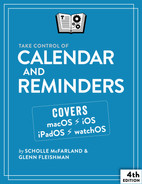Calendar vs. Reminders
Apple offers two apps to help you keep track of your life, Calendar and Reminders, but not everyone is clear about when to use which. The first step to becoming organized, then, is learning which tool is best for the job at hand.
Calendar
The basic unit of the Calendar app is an event: a unique entry that can occur once or repeatedly, cover an entire day (like a birthday or holiday) or multiple days, or happen during a range of time. A calendar event can link to an email message with relevant information or contain the responses to invitation you sent to others. Best of all, Calendar can remind you about your commitments with alarms.
Use Calendar to:
See an overview of your day, week, or month (Figure 1).

Figure 1: Get an overview of your day with Calendar. Track your daily schedule.
Invite others to meetings.
Accept or decline invitations to meetings.
Share a calendar with colleagues or family members.
Subscribe to others’ calendars, for example, your school district or favorite sports team’s schedule.
Link to URLs, files, or a relevant email to make it easier to prepare for a meeting.
Enter event locations so you can get directions when you need them from Maps.
Set alarms to ensure you’re not late.
Reminders
Apple’s Reminders app fits a different niche than the Calendar app and has a hierarchy of organization. Rather than being organized around an event, once or recurring, reminders work like this:
A reminder is a named item that can have attributes attached, like a color, link, image, date and time by which it’s due, and other things. A reminder can occur on a repeated basis, and it can be marked as a completed (for a single instance or a given instance).
Reminders are organized into lists, each of which has a name and icon. They appears in the Reminders sidebar. Lists can be grouped in the sidebar into something like a folder.
Reminders can be also be filtered by characteristics into smart lists, which appear in the Reminders sidebar.
There’s a laundry list of things you can use reminders for:
Lists and to-dos: Reminders offers basic task management that’s not possible in Calendar. Use it to assemble and check off items in lists, as well as to share lists with others and assign tasks to the right person. For instance, use a shared list to divide up the weekly household chores in your family. Assign each task and you’ll always know who is in charge of what. Do the same for tasks in a project or your honey-do list.
Remembering random tasks and cutting calendar clutter: Use Apple’s Reminders to remember the random tasks that come your way, from calling back the pharmacy to picking up cat food (Figure 2). You can also use it to remind yourself of chores you don’t want cluttering your calendar, like your weekly commitment to take out the recycling.

Figure 2: Reminders can help you remember the random tasks that come your way, as well as give you a place to check off to-do items as you complete them. Remembering something at a certain place: Worried you’ll forget to preheat the oven when you get home? One of the app’s special powers is location-based alerts. In other words, the app can remind you to turn on the oven not just at a certain time, but when you reach a certain place. To take advantage of this feature, you need an iPhone.
Remembering something when you message someone: Whether you need to ask your spouse to get milk on the way home or your kid to fill out a form, Reminders can remind you to do something when you talk with a certain person via Messages.
Remembering emails you need to deal with: When you don’t have time to act on an email, it’s easy to create a reminder to help. When you do, it even includes a link back to the message, so you can find the information when you need it.
Viewing the past: Unless you delete past entries, Calendar maintains a perfect history of all your old appointments and events that can be viewed just as easily as anything in the current day, week, or month, or scheduled for the future. Reminders retains completed items, too, but it’s a massive list of past tasks—you can browse that history or search it, but it doesn’t have the same connection to date and time found in Calendar.
